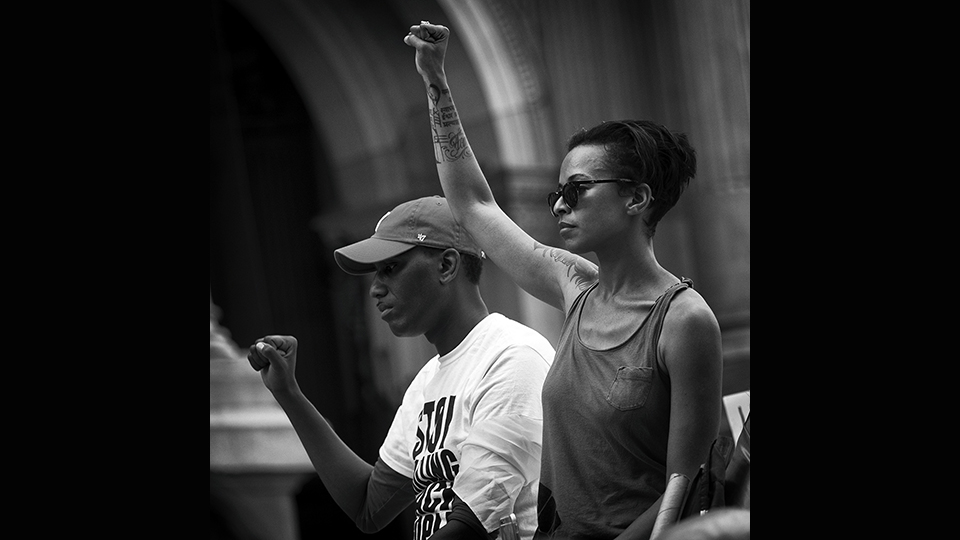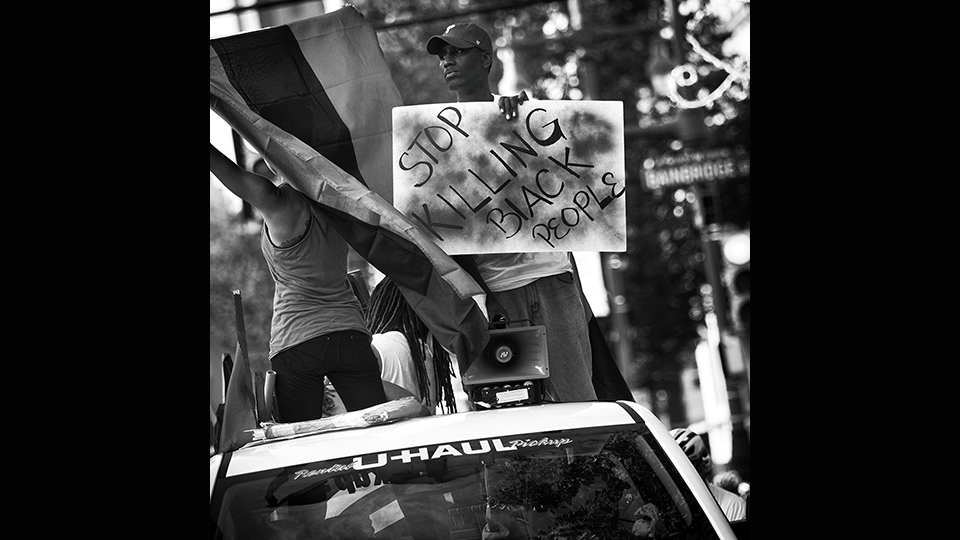SPECIAL PROJECTS AND COMMISSIONS
Sheila Pree Bright / Photography Commission
History moves quickly and happens under our noses. Open your feed — there it is. It is everywhere and it is growing. It is also, like all social movements, complex, yet comprised of individuals. Black Lives Matter is a truly important and historically groundbreaking movement that has changed the conversation of race in America. For the 2016 Creative Time Summit, we commissioned Sheila Pree Bright to continue to follow #BLM as it waged strong in Baton Rouge and Atlanta, and it came head to head with the DNC in Philadelphia. Portraying the stunning energy of the growing movement, Bright’s images also show the joy, pain, hardship, and determination connected to the tragedy of violence against people of color. Shared primarily through the accessible platforms of social media, her images show a complex collective of queer, straight, and multi-generational protest and solidarity, capturing the mood of resistance across the American landscape.
The work was presented by Bright during the Summit as well as through an ongoing social media campaign (@sheepreebright).
The Great Tortilla Conspiracy
The Great Tortilla Conspiracy created an artist lunch during the first day of the Summit, serving tortillas printed with political messages just in time for the US Election!
About The Great Tortilla Conspiracy
The Great Tortilla Conspiracy (GTC) is “the world’s most dangerous tortilla art collective,” specializing in serving up digestible satire for the masses. The founding document of the Conspiracy cites the miraculous appearance of several deities, not least of which is the Virgin of Guadalupe, upon various surfaces—clouds, rocks, folded laundry, as well as upon various foodstuffs, most famously toast. The GTC was founded in the early days at the Galeria de la Raza in the Mission District of San Francisco by artist Rene Yañez, who was then joined by co-conspirators Jos Sances, Rio Yañez, and Art Hazelwood. Since then, the collective has spread political messages far and wide through the edible delivery system of the tortilla. The art consumer can both eat and enjoy the aesthetic sensation that is the Great Tortilla Conspiracy.
CULTURUNNERS
Against the backdrop of the 2016 US Presidential elections, CULTURUNNERS has been inviting artists to explore interconnected histories and common concerns between the United States and Middle East. Tailing the US Presidential campaign trails, CULTURUNNERS follows the ideological and geographical journeys of the candidates, offering alternative perspectives on the issues being discussed. Working out of their RV turned art and community space, CULTURUNNERS have traveled across the US and Mexico, and landed in Washington DC for the Creative Time Summit. Parking their RV behind the Lincoln Theatre, attendees could visit to learn about the artists’ journeys and see a special exhibition by Sudanese political cartoonist, @KhalidAlbaih.
About CULTURUNNERS
CULTURUNNERS is an independent organization which mobilizes international artists to tell stories and create art across physical and psychological borders. In prioritizing direct encounters and storytelling, CULTURUNNERS believes in the power of artists’ journeys to uncover counter narratives and inspire greater empathy between contested communities around the world. While traveling with CULTURUNNERS, artists host exhibitions, talks and workshops, and collaborate with resident film-makers and journalists to broadcast mobile dispatches via media channels and CULTURUNNERS interactive website.
Summit Stage
The Occupy the Future stage was created by DC’s Floating Lab Collective. Their design takes inspiration from Michelangelo’s Sistine Chapel, reimagining the visual metaphors for social progress found in the great Renaissance work as key figures, movements and symbols of contemporary social change. Created specifically for the historic Lincoln Theatre, the design celebrated Pussy Riot, Occupy, Hong Kong’s Umbrella protests, Black Lives Matter, the three finger salute in Thailand, and others acts of resistance from around the world.
About Floating Lab
Floating Lab Collective is a group of artists working collaboratively on social research in the context of public and media art. Bringing an array of creative social practices into public space and communities, FLC’s reach spans the mid-Atlantic region and beyond. All projects are socially and aesthetically experimental and arise in direct and integrative response to specific times, places and communities. Participating artists are cross-disciplinary and flexible in responding to the nature of project topics such as housing, the environment, labor, and urban mobility. Floating Lab Collective was started in 2007 in partnership with Provisions Library, an arts and social change agency in Washington, DC. Working with Provisions, over 50 groundbreaking and generative projects have been accomplished in DC, Baltimore, Detroit, Kentucky, Medellin-Colombia, Trinidad and Tobago and Haiti. One of FLC’s most important tools is a converted taco truck – a Floating Museum – that circulates projects among different neighborhoods, communities and region.
Voices of a People’s History of the United States
Building on the work of historian Howard Zinn (1922–2010), Voices of a People’s History of the United States brings to light little known voices from U.S. history, including those of women, African Americans, Native Americans, immigrants, and laborers. By giving public expression to rebels, dissenters, and visionaries from our past—and present—they work to educate and inspire a new generation of people working for social justice. Performers for Voices at Creative Time Summit include Staceyann Chin, Wallace Shawn, Hari Kondabolu, and Deva Mahal, and Laura Gómez.
Rizopolis
Mobile Analog Printshop
Christopher Kardambikis and his team of printing devils live-produced Riso-printed cards, broadsides and zines throughout the Summit from the Floating Lab Collective truck parked behind the theatre. Presenters and attendees are invited to submit texts and images to the mobile printshop for printing and distribution. Working in tandem, special collaborator Tim Schwartz scanned, altered, redacted and uploaded printed items to a special website on the Dark Net.
About Christopher Kardambikis
Christopher Kardambikis explores absurd mythologies of the future through DIY artists’ publications. He has co-founded three artist book projects: Encyclopedia Destructica in Pittsburgh, Gravity and Trajectory in San Diego, and 90 Proof Press in Los Angeles. He is currently head of Printmaking at George Mason University.
About Tim Schwartz
Tim Schwartz is a Los Angeles-based artist, technologist, and activist who makes works of art focused on technology, information, privacy, and how our culture absorbs– and fails to absorb– changes in these areas. Schwartz is also a member of the collective LA Cryptoparty which does workshops, lectures, and performances around issues of security and privacy through art.
Contribute to artist Gluklya’s Museum of Utopian Clothes
Russian artist Gluklya (Natalia Pershina-Yakimanskaya) and curator Anna Bitkina presented Debates on Division: When Private Becomes Public, a performance and installation during Creative Time’s 2016 Summit: Occupy the Future!
In her projects, Gluklya often uses clothes as a tool to build a connection between art and everyday life. Addressing the personal stories of her characters, the artist analyzes the relationship between the private and the public, exposing the conflict between the inner world of a person and the political system.
During the Summit, Gluklya created a local socio-political narrative by including attendees’ input into a performance on the Summit stage.
About Gluklya:
Born in Leningrad, Natalia Pershina-Yakimanskaya (also known as Gluklya) lives and works in St. Petersburg and Amsterdam. After graduating from the Mukhina Academy of Art and Design, she co-founded the artist collective The Factory of Found Clothes (FFC), which uses installation, performance, video, text and “social research” to develop the concept of “fragility” – relationships between internal and external and private and public.
Gluklya’s works have been extensively exhibited in Russia and abroad. Most notably, in 2015 she participated in the 56th Venice Biennale of Art, “All the World’s Futures,” curated by Okwui Enwezor. Gluklya is a co-founder and member of the art group ‘Chto Delat?’ (What is to Be Done?). For more on Gluklya, click here.
About Anna Bitkina:
Anna Bitkina is an independent curator, director and co-founder of The Creative Association of Curators TOK (www.tok-spb.org), an art organization that conducts interdisciplinary projects in the fields of contemporary art, design and social sciences. TOK’s projects have a strong social component and deal with current issues that are widely discussed both in Russia and internationally. In her curatorial practice she is interested in issues related to the concept of public space in post-Soviet Russia, as well as on perception, understanding and mechanisms of use of public spaces and open areas by residents of post-Soviet cities. In her projects she explores the changing role of cultural workers and possibilities of creative practices in different social spheres.
About the Museum of Utopian Clothes:
Museum of Utopian Сlothes is a laboratory that questions core principles of consumerism, and maps out alternative ways for fighting the contradictions of capitalism. The Utopian Clothes, different to their everyday function within society, generate another language – the language of oppressed feelings. For more information, click here.
Image Credits:
Photo by Sheila Pree Bright, part of the #1960Now series.
Photo by Sheila Pree Bright, part of the #1960Now series.
Photo courtesy of The Great Tortilla Conspiracy.
Natalya Pershina-Yakimanskaya (Gluklya), “Debates on Division: When Private Becomes Public”, 2014
Documentation of the performance at the New Stage of the Aleksandrinsky Theatre in St Petersburg. Photo: Nikolay Simonovsky (2014)




